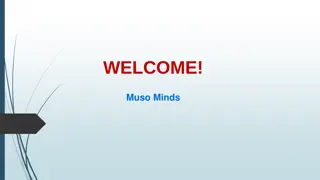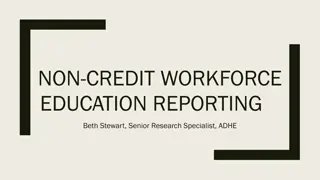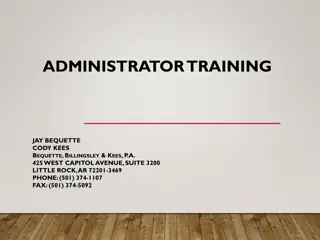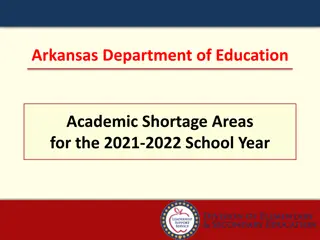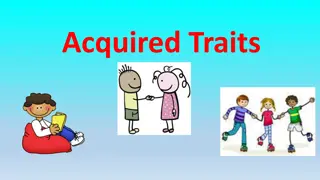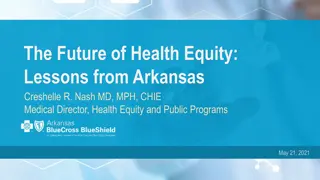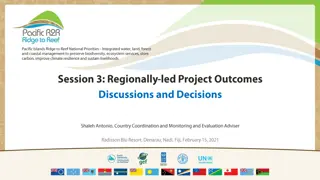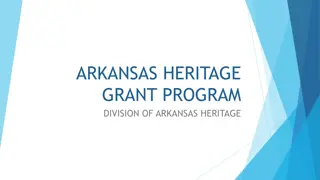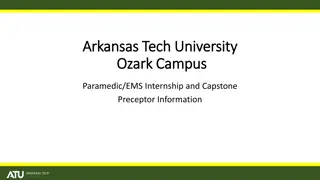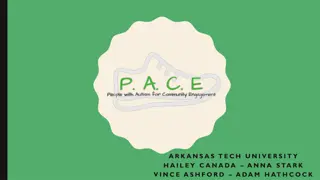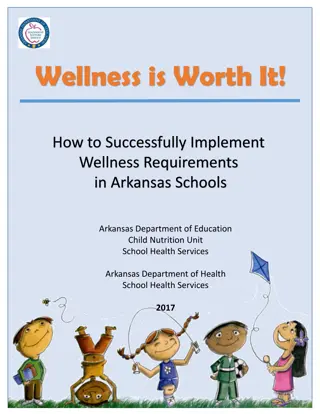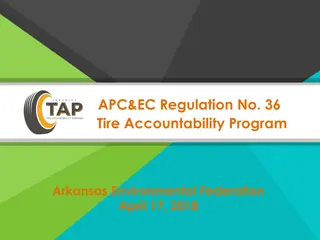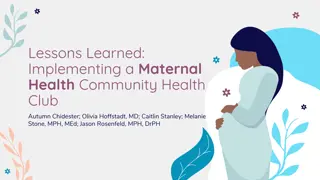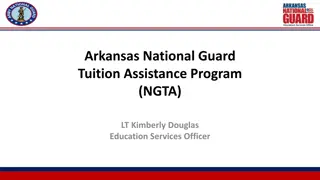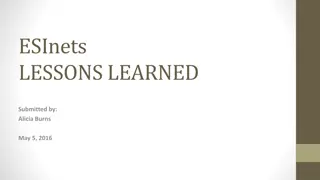Lessons Learned Implementing Online Education at the University of Arkansas
Providing online opportunities at the University of Arkansas began in 2012 to address shortages in lecture theater seating, starting with online physics options. The transition from traditional face-to-face classes to blended courses was discussed, highlighting minimal changes in course structure. The focus was on University Physics II and the incorporation of online elements alongside existing lecture and laboratory formats.
Download Presentation

Please find below an Image/Link to download the presentation.
The content on the website is provided AS IS for your information and personal use only. It may not be sold, licensed, or shared on other websites without obtaining consent from the author.If you encounter any issues during the download, it is possible that the publisher has removed the file from their server.
You are allowed to download the files provided on this website for personal or commercial use, subject to the condition that they are used lawfully. All files are the property of their respective owners.
The content on the website is provided AS IS for your information and personal use only. It may not be sold, licensed, or shared on other websites without obtaining consent from the author.
E N D
Presentation Transcript
LESSONS LEARNED IMPLEMENTING ONLINE EDUCATION AT THE UNIVERSITY OF ARKANSAS Dr. John Stewart
NO MOOCS This talk is not about MOOCs, but non- MOOC online physics education (where the money is). This talk discusses the addition of online elements to well-understood face-to- face (f2f) physics classes.
ONLINE EDUCATION AT THE UNIVERSITY OF ARKANSAS Providing online opportunities was expressed as a system-wide goal in Fall 2012. To address this goal and to alleviate serious shortages in large lecture theater seating, online physics options began to be offered in the Fall 2012 semester.
UNIVERSITY PHYSICS II The course studied is the second-semester, calculus-based, introductory physics class at the University of Arkansas. The class has been presented in the same format by the same lead instructor for over a decade. The course features interactive laboratories, excellent TA training, and has been a centerpiece of the Arkansas Physics Program and its PhysTEC site.
COURSE STRUCTURE (BEFORE ONLINE) Lecture was presented during two 50-minutes sessions each week with attendance managed with a lecture quiz. Two two-hour laboratory sessions were required each week involving hands-on activities, small group work, traditional experiments, and interactive demonstrations. Students were required to turn in open- response and multiple-choice homework before each lecture.
COURSE STRUCTURE (AFTER ONLINE) Online and Face-to-Face (f2f) lecture sections were offered both presenting the same 50 minute lecture twice a week. Online lecture sections used videos of the f2f lecture cut into 5-15 minute segments each accompanied by a lecture quiz question. The laboratory experience was unchanged. Students were required to turn in open-response homework after the last lab and multiple-choice homework before each lecture.
IN SHORT The class was virtually (ha ha) unchanged by the introduction of the online option except some students could watch the lecture on video. This talk will discuss our experiences in transition this f2f course to a blended course.
Students Self-Select Online Options EXPERIMENT I
STARTING ONLINE LECTURE FALL 2012 A policy allowing students (N=168) to watch the lecture as a video online was implemented mid-semester in Fall 2012. Students self-selected the number of lectures watched on video. All students attended a face-to-face lab and the lab experience was not modified; thus a student could choose to convert a face-to-face course into a blended course. The replacement of 8 of the 12 lectures remaining in the semester with video was measured using an online quiz taken with the video.
VIDEO USE Video Lecture Use Non- User 90 80 70 Low User 60 Students 50 High User 40 30 20 10 0 0 1 2 3 4 5 6 7 8 Number of Face-to-Face Lectures Replaced with Video
ENGAGEMENT CHANGES CHANGE IN THE RATE ASSIGNMENTS ARE SUBMITTED Overall (%) Non-User (%) BV AV BV AV Lecture Quiz 91.9 82.7 -9.3b 95.1 85.5 Low User (%) BV 93.8 83.5 High User (%) BV 84.4 76.8 AV AV -9.6b -10.3b -9.6a Laboratory 97.7 96.6 -1.1a 98.6 97.4 -1.2a 98.5 96.8 -1.6a 95.3 94.8 -0.5 Multiple- Choice Homework Open- Response Homework Optional Assignments 93.4 90.1 -3.3b 94.3 90.8 -3.5b 94.3 91.7 -2.6 90.8 87.1 -3.7 90.8 88.9 -1.9 93.0 90.0 -3.0 92.5 92.0 -0.4 85.0 83.7 -1.3 30.4 26.2 -4.2 33.3 23.1 -10.3 39.1 30.4 -8.7 15.9 27.3 11.4 The superscript a indicates significance at the 5% level; b significance at the 1% level. BV=Before Video AV=After Video
ENGAGEMENT RESULTS Paired t-tests indicate that some of the changes before video (BV) to after video (AV) were statistically significant. Analysis of variance showed that the level of video use was not a significant treatment effect on the change in submission rates of any assignment type; watching more video did not indicate a greater decrease in submission rate. Students electing the video option at high levels had lower submission rates before the availability of the video policy; this difference continued after the policy was introduced.
ACHIEVEMENT CHANGES Overall AV 74.8 Non-User AV 77.0 Low User BV 73.1 74.3 High User AV 71.4 BV 73.7 BV 76.4 AV BV 69.6 Tests 1.1 0.6 1.3 1.8 Open- Response Homework 68.7 70.3 1.6 72.3 74.1 1.8 71.2 70.5 -0.7 59.5 63.1 3.5 Multiple- Choice Homework 58.5 58.4 -0.1 60.8 61.4 0.6 59.7 60.7 1.0 53.0 50.5 -2.6 BV=Before Video AV=After Video
ACHIEVEMENT RESULTS A paired t-test showed that differences for all assignment types were not significant. Analysis of variance showed that the level of video use was not a significant treatment effect for the change in achievement for any assignment type. Students electing high use of the video option were lower achieving before and after the video option; weaker performing students preferentially elected the video option.
NOTE TAKING BEHAVIOR Students were surveyed about the way they took lecture notes after the first and third exams.
Question: Circle the ONE of the following that best describes how you obtain lecture notes Overall Percent Non-User Percent Low User Percent High User Percent BV 67.72 AV 59.63 BV 78.67 AV 73.97 BV 65.12 59.09 AV BV 50.00 36.36 AV I take my own lecture notes. I print or read the lecture notes at the website after lecture. I print the lecture notes from the website before lecture and follow along during lecture. I print the lecture notes from the website before lecture, follow along during lecture, and add my own notes. I do not take lecture notes nor do I read the lecture notes at the website. 8.23 13.04 4.00 10.96 13.95 4.55 10.00 25.00 3.16 10.56 1.33 5.48 0.00 15.91 10.00 13.64 18.99 14.91 14.67 9.59 18.60 20.45 27.50 18.18 1.90 1.86 1.33 0.00 2.33 0.00 2.50 6.82
NOTE TAKING RESULTS Students electing a high level of video use used less engaged note taking behavior before the video option was introduced. Students electing a high level of video use changed their note taking behavior to even more less engaged note taking methods after the introduction of the video option.
RESULTS OF EXPERIMENT I Students electing a high level of video use were less engaged and lower achieving both before and after the video option was made available. The level of video use was not a significant treatment effect for the change in engagement or achievement for any assignment type. The level of video use ceased to be a significant treatment effect for exam scores after the video option was introduced; high video users caught up a bit.
RESULTS OF EXPERIMENT I Weaker students self-select online options. Generally it doesn t hurt them. There is the slightest evidence that it helps somewhat.
Required Online Lecture Sections EXPERIMENT II
ONLINE LECTURE SECTIONS Starting in Spring 2013, students could elect online sections of the lecture and were required to attend no f2f lectures. The lab requirements were unchanged.
MOSTLY THINGS WERE FINE Experiment I demonstrated that online lecture was educationally equivalent and the lab experience meant the online lecture students still attended four hours of f2f lab each week.
BUT.. ONLINE STUDENTS FAIL AT HIGHER RATES
MORE ONLINE STUDENTS ARE REPEATING THE CLASS
AND NOT SUCCEEDING Repeat Only Students - All Repeats Grade A B C D F W N-Normal Average N-Online Average 5 4.81 35 33.65 32 30.77 11 10.58 7 6.73 14 13.46 2 4 3 2 6 9 7.69 15.38 11.54 7.69 23.08 34.62
STUDENTS SUCCESSFULLY REPEATING THE CLASS Non- Online Fall 11-Spring 12 Total Online Total Enrollment Students Repeating Repeat Rate Successful Repeats Success Rate 463 11 2.38 11 8 8 72.73 72.73 Fall 13-Spring 14 Total Enrollment Students Repeating Repeat Rate Successful Repeats Success Rate 595 21 3.53 464 131 14 7 1.51 10.69 7 5 2 33.33 71.43 14.29
NOT THE WHOLE PROBLEM DFW Rate Correcting for Repeat Students Total Online Total Enrollment 595 131 Original DFW Count 105 47 DFW Rate 17.65 35.88 Corrected DFW 98 40 Corrected Rate 16.47 30.53
RESULTS OF EXPERIMENT II While educationally equivalent, the introduction of online lecture sections produced unforeseen negative impacts on the course studied.
Online Laboratories EXPERIMENT III
ONLINE LABORATORIES FOR PHYSICS I As part of an effort to improve the success of transfer students, the College of Engineering at the University of Arkansas asked that the University Physics I class be offered in a blended model to all students in the Arkansas system.
CREATING THE BLENDED CLASS One laboratory session each week was identified that could be converted to an online experience. Students still attend one face-to-face laboratory session each week.
HOME-GROWN SIMULATIONS Javascript+HTML5+SVG
VIDEO RECORDED LABORATORIES
VIDEO RECORDED INTERACTIVE DEMONSTRATIONS
LEARNING OUTCOMES UNCHANGED Students performed equivalently on in- semester examinations and the Force Concept Inventory.
STUDENTS FIND THE FACE-TO- FACE LABORATORY EXPERIENCE MORE VALUABLE. How does the educational value of the online laboratories compare with the educational value of the laboratories you do in class? The face-to-face labs are much more valuable. The face-to-face labs are a little more valuable. They are about the same. The online labs are a little more valuable. The online labs are much more valuable. 0 5 10 15 20 25 30 35 40 45 50 Percentage
WHAT ARE ONLINE LABS MISSING? Feature Being able to use real equipment Being able to see a demonstration in person Being able to discuss lab with lab partners Being able to get help from a TA when I m stuck Being able to listen to the TA s introduction of the lab in person Importance 6.9 7.5 7.9 9.0 7.8 Being able to ask the TA general physics questions like questions about homework Having to come to a lab at a specific time so I don t put it off 8.6 7.2 Students were asked to rate the importance of various features missing from online labs on a 10 point scale with 10 as most important.
WHAT FEATURES WOULD YOU FIND MOST VALUABLE IF ADDED TO ONLINE LABS? Feature Online discussion board for each part of the activity Video help for each part of the activity Frequently Asked Questions for the activity Online chat rooms with other students on the activity Online chat room moderated by a TA on the activity TA dedicated to answer questions by email during day Small labs done with simple equipment at home Video conference office hours with a TA Help text tied to the parts of the activity More Test Your Understanding Questions Importance 3.9 5.1 5.1 3.7 4.6 5.0 3.4 3.7 4.8 3.8 Importance on seven point scale.
RESULTS OF EXPERIMENT IV The primary feature the students miss in the face-to-face laboratory was having a TA present to provide immediate help. The primary features the students would like added to the online lab are traditional asynchronous methods of providing online help.
What do students think? EXPERIMENT IV
ONLINE/FACE-TO-FACE DECISION Students were surveyed about their choice of online or face-to-face lecture in the Spring 2014 semester.
WHY DID YOU TAKE THE ONLINE SECTION? Percent The face-to-face lecture section was full and this was the only way I could get into the class. There was another class I wanted to take at the same time as the lecture. I had personal or work commitments that conflicted with the face-to-face lecture. I like the flexibility of an online class. I think I learn better using online lectures than face-to-face lectures. Other. (One other response-class was full) 38.6 36.4 4.5 15.9 2.3 2.3
HOW WOULD YOU COMPARE THE EDUCATIONAL VALUE OF THE ONLINE LECTURE TO A SIMILAR LECTURE ATTENDED IN A FACE-TO-FACE SETTING (ONLINE STUDENTS)? Percent The online lectures are much more valuable than similar face- to-face lectures. The online lectures are somewhat more valuable than similar face-to-face lectures. The online lectures are equally valuable to similar face-to-face lectures. Face-to-face lectures are somewhat more valuable than similar online lectures. Face-to-face lectures are much more valuable than similar online lectures. The online lectures are much more valuable than similar face- to-face lectures. 4.7 23.3 11.6 51.2 9.3 4.7
IF YOU COULD, WOULD YOU SWITCH FROM ONLINE TO FACE-TO-FACE? If you could, would you switch sections? Online Percent Yes No Face-to-Face Percent 61.4 38.6 16.5 83.5
CAUTIONARY TALE I The online laboratories were profoundly more expensive than the university was will to support. They also needed additional support (curation) that the university had no plans to fund.
CAUTIONARY TALE II Even the most passive change (online lecture) to an exceptionally stable and well- understood class had unexpected negative consequences for some populations of students.
CONCLUSION Online physics education appears not to harm most students, but much more research is needed before it can be presented with confidence.





